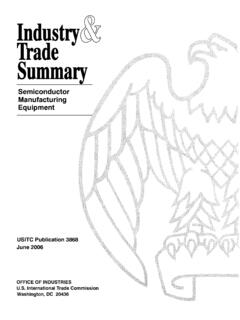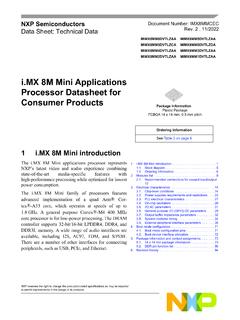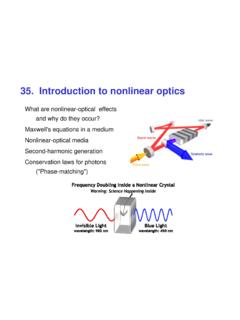Transcription of Douglas Montgomery's Introduction to Statistical Quality ...
1 The correct bibliographic citation for this manual is as follows: Ramirez, Brenda S., , and Jose G., Ramirez, 2018. Douglas Montgomery's Introduction to Statistical Quality Control: A JMP Companion. Cary, NC: SAS Institute Inc. Douglas Montgomery's Introduction to Statistical Quality Control: A JMP Companion Copyright 2018, SAS Institute Inc., Cary, NC, USA. 978-1-63526-022-9 (Hard copy). 978-1-63526-825-6 (Web PDF). 978-1-63526-823-2 (epub). 978-1-63526-824-9 (mobi). All Rights Reserved. Produced in the United States of America.
2 For a hard copy book: No part of this publication may be reproduced, stored in a retrieval system, or transmitted, in any form or by any means, electronic, mechanical, photocopying, or otherwise, without the prior written permission of the publisher, SAS Institute Inc. For a web download or e-book: Your use of this publication shall be governed by the terms established by the vendor at the time you acquire this publication. The scanning, uploading, and distribution of this book via the Internet or any other means without the permission of the publisher is illegal and punishable by law.
3 Please purchase only authorized electronic editions and do not participate in or encourage electronic piracy of copyrighted materials. Your support of others' rights is appreciated. Government License Rights; Restricted Rights: The Software and its documentation is commercial computer software developed at private expense and is provided with RESTRICTED RIGHTS to the United States Government. Use, duplication, or disclosure of the Software by the United States Government is subject to the license terms of this Agreement pursuant to, as applicable, FAR , DFAR (a), DFAR (a), and DFAR , and, to the extent required under federal law, the minimum restricted rights as set out in FAR (DEC 2007).
4 If FAR is applicable, this provision serves as notice under clause (c) thereof and no other notice is required to be affixed to the Software or documentation. The Government's rights in Software and documentation shall be only those set forth in this Agreement. SAS Institute Inc., SAS Campus Drive, Cary, NC 27513-2414. October 2018. SAS and all other SAS Institute Inc. product or service names are registered trademarks or trademarks of SAS Institute Inc. in the USA and other countries. indicates USA registration. Other brand and product names are trademarks of their respective companies.
5 SAS software may be provided with certain third-party software, including but not limited to open-source software, which is licensed under its applicable third-party software license agreement. For license information about third-party software distributed with SAS software, refer to Contents Foreword .. v About This Book .. vii Acknowledgments .. xiii Chapter 1: Using This Book ..1. Overview ..1. Chapter Contents ..1. Chapter JMP Software and JMP Tables ..9. Typographical Conventions ..12. Chapter 2: Overview of Statistical Quality Control Topics and Overview.
6 15. Statistical Process Control ..15. Measurement System Analysis ..24. Process Health Assessment ..30. Chapter 3: Control Charts for Variables ..37. Overview ..37. Variables Control Chart Review ..37. JMP Variables Control Chart Platforms ..38. Examples from ISQC Chapter 6 ..39. Statistical Chapter 4: Control Charts for Attributes ..75. Overview ..75. Attributes Control Chart Review ..75. JMP Attributes Control Chart Examples from ISQC Chapter 7 ..77. Statistical Chapter 5: Process and Measurement System Capability Overview.
7 127. Process and Measurement System Capability Analysis Review ..127. JMP Process Capability and MSA Examples from ISQC Chapter 8 ..131. Statistical iv Contents Chapter 6: Process Health Overview .. 183. Process Health Assessment Review .. 183. JMP Platforms for Process Health Assessments .. 185. Examples for Chapter 6 .. 186. Statistical Insights .. 217. Chapter 7: Cumulative Sum and Exponentially Weighted Moving Average Control Charts ..225. Overview .. 225. CUSUM and EWMA Control Chart Review .. 225. JMP Small Shift Detection Control Chart 227.
8 Examples from ISQC Chapter 9 .. 228. Statistical Insights .. 253. Chapter 8: Other Univariate Statistical Process Monitoring and Control Techniques ..267. Overview .. 267. Special Topics Review .. 267. JMP Platforms for Monitoring Autocorrelated Processes .. 269. Examples from ISQC Chapter 10 .. 270. Statistical Insights .. 285. Chapter 9: Multivariate Process Monitoring and Control ..307. Overview .. 307. Multivariate Process Monitoring Review .. 307. JMP Multivariate Monitoring Platforms .. 308. Examples from ISQC Chapter 11.
9 309. Statistical Insights .. 331. References ..339. About This Book Why Statistical Quality Control? What comes to mind when you think of Statistical Quality control (SQC)? The Encyclopedia Britannica defines this phrase as the use of Statistical methods in the monitoring and maintaining of the Quality of products and services. This definition is in line with our initial exposure to SQC during our college years, in classes like Statistical Process Control. These ideas continued to take shape when we studied for the American Society for Quality Certified Quality Engineering exam, which had us memorize numerous facts about different Statistical Quality tools.
10 But it was not until we started using these tools and techniques in a real-world manufacturing environment that we truly understood their impact on improving products and processes. Thirty years and several industries later, we have become great stewards of SQC techniques, and their use and application have become second nature. Therefore, when we were asked to author a companion book to Prof. Montgomery's Introduction to Statistical Quality Control (ISQC), we enthusiastically agreed. Like many, we were introduced to his work through his many books.















